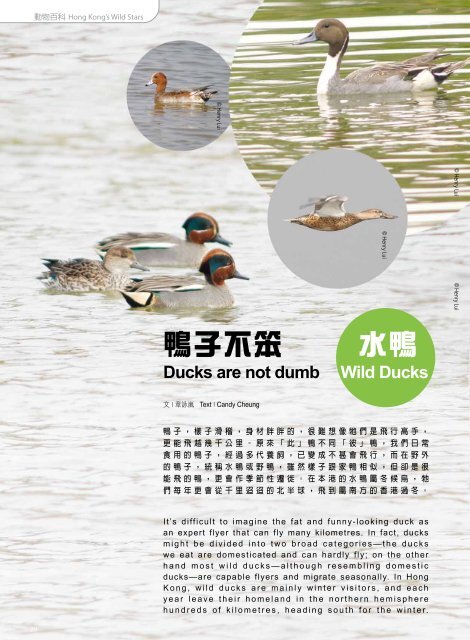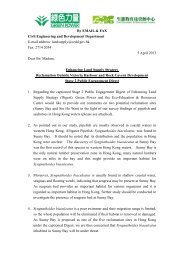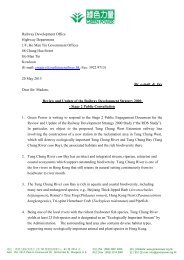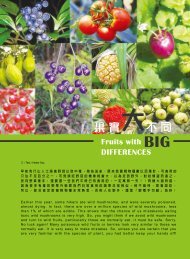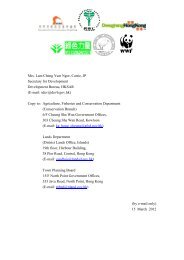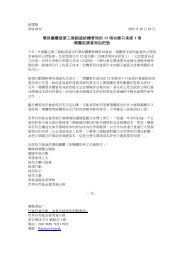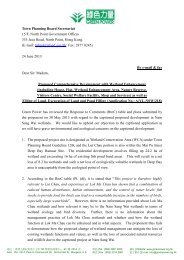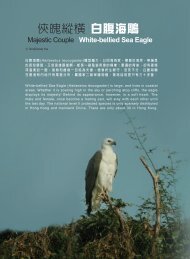You also want an ePaper? Increase the reach of your titles
YUMPU automatically turns print PDFs into web optimized ePapers that Google loves.
動 物 百 科 Hong Kong’s Wild Stars<br />
© Henry Lui<br />
© Henry Lui © Henry Lui<br />
© Henry Lui<br />
鴨 子 不 笨<br />
Ducks are not dumb<br />
水 鴨<br />
Wild Ducks<br />
文 | 章 詠 嵐 Text | Candy Cheung<br />
鴨 子 , 樣 子 滑 稽 , 身 材 胖 胖 的 , 很 難 想 像 牠 們 是 飛 行 高 手 ,<br />
更 能 飛 越 幾 千 公 里 。 原 來 「 此 」 鴨 不 同 「 彼 」 鴨 , 我 們 日 常<br />
食 用 的 鴨 子 , 經 過 多 代 養 飼 , 已 變 成 不 甚 會 飛 行 , 而 在 野 外<br />
的 鴨 子 , 統 稱 水 鴨 或 野 鴨 , 雖 然 樣 子 跟 家 鴨 相 似 , 但 卻 是 很<br />
能 飛 的 鴨 , 更 會 作 季 節 性 遷 徙 。 在 本 港 的 水 鴨 屬 冬 候 烏 , 牠<br />
們 每 年 更 會 從 千 里 迢 迢 的 北 半 球 , 飛 到 屬 南 方 的 香 港 過 冬 。<br />
It’s difficult to imagine the fat and funny-looking duck as<br />
an expert flyer that can fly many kilometres. In fact, ducks<br />
might be divided into two broad categories—the ducks<br />
we eat are domesticated and can hardly fly; on the other<br />
hand most wild ducks—although resembling domestic<br />
ducks—are capable flyers and migrate seasonally. In Hong<br />
Kong, wild ducks are mainly winter visitors, and each<br />
year leave their homeland in the northern hemisphere<br />
hundreds of kilometres, heading south for the winter.<br />
20
水 鴨 是 冬 候 鳥 , 每 年 秋 冬 時 分 在 本 港 數 量 特 別 多 。<br />
Wild ducks are winter visitors to Hong Kong, and<br />
numbers surge in autumn and winter.<br />
© Henry Lui<br />
© Henry Lui<br />
鴨 子 是 為 人 熟 悉 的 鳥 類 , 屬 鴨 科<br />
( Anatidae) 鴨 屬 (Anas), 廣 泛 分 布 整 個<br />
北 半 球 。 每 年 九 月 , 水 鴨 便 會 開 始 季 節<br />
性 的 遷 徙 , 牠 們 聯 群 結 隊 , 由 族 群 「 首<br />
領 」 帶 領 , 陸 續 從 北 半 球 如 俄 羅 斯 、<br />
中 國 東 北 等 地 飛 到 南 方 溫 帶 、 亞 熱 帶 和<br />
熱 帶 地 區 , 有 些 會 在 香 港 及 台 灣 等 地 停<br />
留 , 有 些 則 會 再 向 南 遷 , 到 印 尼 、 甚 至<br />
澳 洲 度 冬 。 到 了 三 、 四 月 份 , 南 方 開 始<br />
踏 入 春 季 , 牠 們 便 會 飛 回 北 方 , 繁 殖 下<br />
代 。 在 本 港 , 天 水 圍 、 南 生 圍 、 米 埔 、 后<br />
海 灣 一 帶 的 河 道 和 濕 地 泥 灘 都 可 找 到 水<br />
鴨 , 最 常 見 的 有 綠 翅 鴨 (Anas crecca)、<br />
針 尾 鴨 (Anas acuta)、 琵 嘴 鴨 (Anas<br />
clypeata) 和 赤 頸 鴨 (Anas penelope) 等 。<br />
Wild ducks belong to the Anas genus<br />
of the Anatidae family and are widely<br />
distributed in the northern hemisphere.<br />
In September each year, they start<br />
their seasonal migrations in flocks.<br />
They leave from northern places like<br />
Russia and Northeast China and fly<br />
to temperate, subtropical and tropical<br />
regions in the south. Some stay in Hong<br />
Kong and Taiwan while some continue<br />
further south to Indonesia and Australia<br />
for overwintering. In March and<br />
April, when spring returns, they<br />
will north to breed. In Hong<br />
Kong, wild ducks can be<br />
found in river channels<br />
and wetland mudflats<br />
at Tin Shui Wai, Nam Sang Wai,<br />
Mai Po and in Deep Bay. The most<br />
common ones are Common Teal (Anas<br />
crecca), Northern Pintail (Anas acuta),<br />
Northern Shoveler (Anas clypeata) and<br />
Eurasian Wigeon (Anas penelope).<br />
© Henry Lui<br />
雄 鴨 的 羽 毛 顏 色 鮮 艷 , 雌 鴨 則 比 較 單 調 。<br />
圖 為 針 尾 鴨 。<br />
The male has colourful plumage while that<br />
of the female is duller. In the photograph<br />
is Northern Pintail.<br />
水 鴨 喜 愛 聯 群 結 黨 暢 泳 。<br />
Wild ducks like to swim in flocks .<br />
© Henry Lui
動 物 百 科 Hong Kong’s Wild Stars<br />
嘴 巴 扁 扁<br />
Flat beak<br />
大 部 分 水 鴨 的 外 型 都 是 雌 雄 有 別 ,<br />
一 般 來 說 , 雌 鴨 羽 毛 顏 色 較 單 調 , 雄<br />
鴨 的 羽 毛 則 較 為 鮮 艷 或 有 花 紋 , 以 便<br />
在 求 偶 時 吸 引 異 性 。 不 過 , 如 果 雄 鴨<br />
未 長 至 成 年 , 外 型 會 跟 雌 鴨 長 得 沒 有<br />
兩 樣 , 而 成 年 雄 鴨 在 繁 殖 期 以 外 的 時<br />
間 , 羽 毛 亦 可 能 與 雌 鴨 一 樣 暗 沉 單 調 。<br />
鴨 子 最 為 人 所 知 的 特 徵 , 是 牠 們 扁 長<br />
的 嘴 巴 。 鴨 子 的 嘴 巴 又 叫 「 喙 」, 從 喙<br />
的 外 型 可 分 辨 鴨 的 食 性 , 如 雜 食 性 的 針<br />
尾 鴨 擁 有 細 長 的 喙 ; 濾 食 泥 中 食 物 的 琵<br />
嘴 鴨 擁 有 又 寬 又 扁 的 喙 ; 其 他 素 食 性<br />
的 鴨 子 則 擁 有 較 短 和 厚 的 喙 。 除 嘴 巴<br />
外 , 鴨 子 也 有 一 對 像 蛙 鞋 般 的 蹼 足 ,<br />
每 個 腳 趾 之 間 都 有 蹼 , 其 作 用 就 如 船<br />
槳 , 幫 助 牠 們 在 水 面 游 泳 或 潛 入 水 中 。<br />
在 本 港 找 到 的 水 鴨 , 大 多 屬 於 「 無<br />
危 」 的 物 種 , 但 在 牠 們 遷 徙 路 線 上 的<br />
城 市 , 不 斷 急 速 發 展 , 將 對 牠 們 帶 來<br />
嚴 重 影 響 。 現 時 雖 有 部 分 濕 地 被 立 為<br />
保 育 區 , 但 實 則 大 部 分 都 不 受 任 何 形<br />
式 保 護 , 沿 岸 的 濕 地 更 因 填 海 不 斷 減<br />
少 , 令 水 鴨 的 中 途 覓 食 和 棲 息 地 大 大 減<br />
少 , 對 牠 們 的 生 存 構 成 了 很 大 威 脅 。<br />
Most wild ducks have different<br />
appearances for the two sexes.<br />
Generally, the female has duller<br />
plumage while the male is more<br />
colourful and has a distinctive pattern<br />
that can attract the female for mating.<br />
However, immature males and adult<br />
males outside reproductive period<br />
resemble the females.<br />
Wild ducks have flattened beaks.<br />
The beak designs depend on the ways<br />
the feed. For example, the omnivorous<br />
Northern Pintail has a slender beak,<br />
filter feeding Northern Shoveler has<br />
a flat and broad beak, and other<br />
vegetarian ducks have shorter, thicker<br />
beaks. Apart from the beak, wild ducks<br />
have a pair of flipper-like webbed feet,<br />
with webs between each of their toes<br />
making them act as paddles to help<br />
them swim or dive.<br />
Most wild ducks found in Hong Kong<br />
are not threatened with extinction.<br />
However, rapid developments of<br />
cities along their migration routes will<br />
seriously impact them. Although some<br />
wetlands are designated as conservation<br />
areas, most are not protected in any<br />
form. Coastal and inland wetlands are<br />
declining due to reclamation, reducing<br />
the feeding areas for wild ducks and<br />
other waterbirds and posing great<br />
threats to their survival.<br />
振 翅 高 飛 的 雄 性 琵 嘴 鴨<br />
High-flying male<br />
Northern Shoveler<br />
© Henry Lui<br />
赤 頸 鴨<br />
Eurasian Wigeon<br />
琵 嘴 鴨 的 嘴 又 闊 大 又 長 , 像 湯 匙 又 像<br />
琵 琶 , 十 分 容 易 辨 認 。<br />
Northern Shoveler has a broad<br />
and long beak that looks like a<br />
spoon, so is easily identified.


